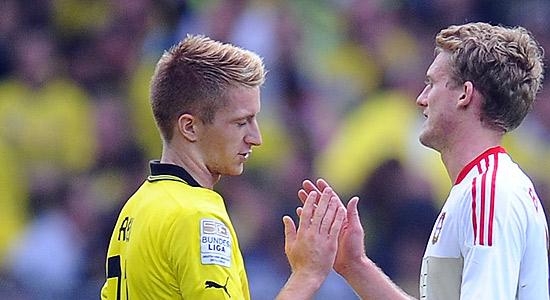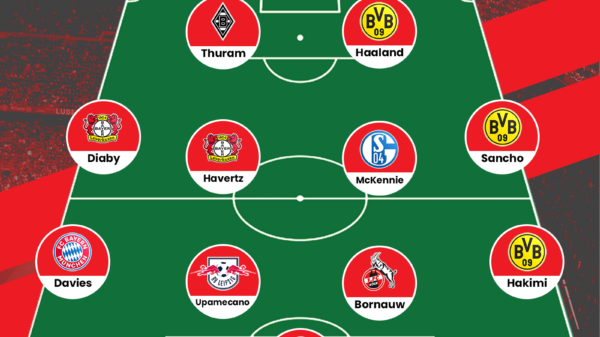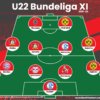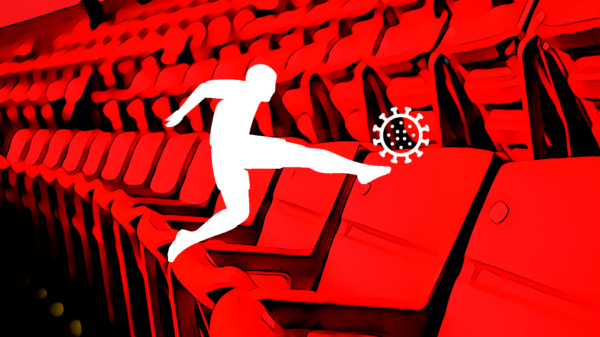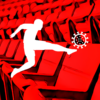It was an enthralling game on Sunday night in the Bundesliga. Two sides looking for champions league spots and trying to keep in touch with runaway leaders Bayern Munich. It was second vs third, and as ever this game did not disappoint.
Leverkusen
Leverkusen started off with their usual 4-3-3 formation, with the in form Kiebling starting up front. The formation employed was narrow which meant that a lot of space was left out wide for Dortmund to exploit. It also meant that the Leverkusen back 4 was well protected.
Leverkusen played a direct passing style at a very high tempo. The counter attacking game they usually employ requires such a speed in order to be successful. The main aim of Leverkusen’s passing on many occasions was to get in behind the Dortmund defence by using the pace of players like Kiebling and Schurrle. In order to achieve this they played the ball back to their defence on several occasions. This way, Dortmund’s high pressing tactic would leave space in behind their defence for the likes of Kiebling and Schurrle. This tactic brought them a goal (their first of the night) when Kiebling managed to break the offside trap and got in behind to set up the goal after a couple of beautiful touches, but on the whole, it wasn’t very effective as a large number of offside decisions went against the home side.
This tactic of drawing Dortmund onto them to create space in behind also meant that Leverkusen had to keep the ball to themselves in deeper areas of the pitch for longer periods of time, leading to them having much more possession than they usually do. To make it clear, Leverkusen bossed the ball in this game, hogging 55% of the ball (their season average before this game was 47%) against a Borussia Dortmund side who usually play possession based football (season average of 57% before this game).
Leverkusen started with a narrow formation, and Dortmund were able to counter this with ease, and therefore, the home side started getting their full backs to use the full width of the pitch and charge down the flank several times. Boenisch and Carvajal had a lot of chances to cross the ball, but didn’t make full use of these opportunities. This is reflected by the fact that only 1 out of 37 crosses were actually completed.
Another major problem that Leverkusen faced was the lack of support up front for Kiebling in the first half. The midfielders were too defensive and the supporting forwards couldn’t get close enough to him. In the second half, Leverkusen turned this around by bringing on Sidney Sam. The diminutive midfielder played almost as a trequartista, and his presence alone provided Leverkusen with a lot more thrust and more options going forward.
Another problem that Leverkusen faced in the first half was the ease with which the Dortmund midfield duo of Gundogan and Bender were able to move the ball to their flair players like Gotze and Reus. In the second half, the Leverkusen midfield started throwing in a lot more challenges. While it affected the game as a spectacle, it certainly worked for Leverkusen as it they managed to wrest control of the game, and dominated the second half. They won 21 of the 23 tackles they attempted, which is a fantastic success rate.
Leverkusen were also made to pay for their inefficiency. This inefficiency in their shooting and in their corner kicks was crucial. Out of the 27 goal attempts, only 2 were scored, with 12 being off target. A particularly important miss came from the left back Boenisch in the second half after Sam had forced Langerak into a fine save.
Dortmund
The German champions started with their usual 4-2-3-1 formation, with Ilkay Gundogan taking charge of midfield along with Sven Bender, who was facing off against twin brother Lars.
In the first half, Dortmund played their usual game, pressing high up the field, and passing the ball very quickly through their inter-play and exchanges. Such movement, with, and without ball was a key element in the first goal, and the penalty that was won. Quite simply put, in the first 10 minutes, Dortmund came out of the blocks much quicker than Leverkusen and caught them napping.
A tactic that worked well for Dortmund on more than one occasion was Mario Gotze dropping deep to collect the ball. This was necessitated by the three midfielders that Leverkusen had on the park, and also planned by Klopp to a certain extent. Gotze dropping deeper allowed him to exchange passes with the likes of Reus and create chances. Lewandowski also moved towards wide areas many times, allowing him and other attackers to burst into the Dortmund penalty area. Such running caused the Leverkusen defense all sorts of headaches in the first half.
Leverkusen focus their counter attacks through their front three, and do not usually employ much width. Klopp had his full backs play especially narrow against Leverkusen to reduce the spaces available to them on the break.
In the second half, the pressing was reduced and Dortmund didn’t press beyond the half line. The defensive line also dropped a lot deeper, allowing Leverkusen the space and time on the ball. The rationale behind this move was to deny Leverkusen space in behind, and disrupt their counter attacking rhythm, but this didn’t quite work out well for Dortmund, as Leverkusen managed to score twice in the second half.
The drop in the defensive and pressure line reduced the chances Dortmund had of holding on to the ball, especially as Leverkusen were now pressing hard, and higher up the pitch.
The champions only completed 67% of their passes in the second half, and the spent the majority of it in their own defensive third.
Dortmund won the game only because of the fact that they managed a very high efficiency going forward. They managed to score thrice in just 12 attempts, and won 2 penalty kicks as well (one of which was missed). They mainly played on the counter, and Lewandowski was isolated for much of the game. This is strange for Dortmund who are used to dominating ball possession. For a team that was expected to exploit wide areas against a Leverkusen side who do not usually play from the wings, Dortmund were inactive. The usual rampaging Marcel Schmelzer was absent, and Pisczek was also unable to influence the game for large parts.
Click here to view all our other tactical analysis
Stats via squawka.com, Pictures via, bundesliga.com, football-talk.co.uk, soccernewsonline.net
- Analysis: Are Chelsea’s pressing issues a concern? - October 5, 2020
- Has Financial Fair Play Been Worth It? - August 27, 2020
- Tactical Philosophy: Frank Lampard - May 20, 2020




















































